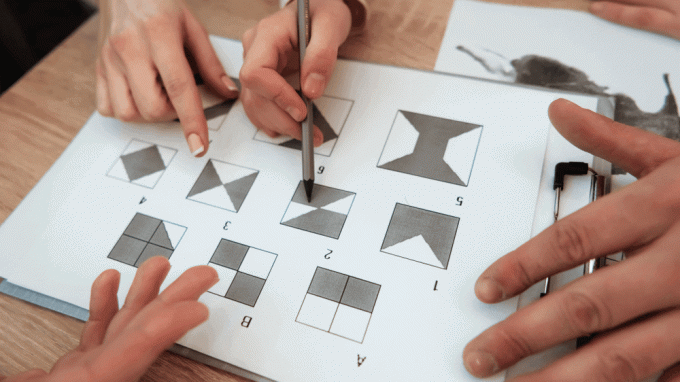The projective tests They are a type of test that is related to the personality where a person has to respond to words, scenes and images that can be confusing. Although there are guidelines to correct projective tests, it may be the case that two participants have different conclusions.
The purpose of this type of test is to achieve know how people work and thereby achieve discover your inner emotions or conflicts that each person can project on the answers. In this way, any of these situations can normally be treated in psychotherapy.
Advertisements
This way of assess personality, has its origin from psychoanalytic studies that determine that everyone has unconscious thoughts and impulses. Through the interpretation of each response, you can deepen your knowledge of feelings, conflicts, desires and emotions that are hidden in the subconscious that could be the cause of various problems.

Advertisements
In this article you will find:
Classification of projective tests
There are different types of projective testsmost used, which will be listed below:
Rorschach projective test
The rorschach inkblot, is one of the first tests of this type that is still one of the known and used. It consists of 10 different cards illustrated with confusing ink stains, where the participant is asked to express what he has seen. Then he must answer what were the characteristics of the image that led him to think about what he saw.
Advertisements
The answers should be recorded in the reduced form possible. The individual's gestures, reactions and tones of voice must be taken into account and according to certain criteria, an analysis will be carried out on each of the responses.
Thematic apperception test
In this test, the individual is asked to make an observation of different images and take a history each of them, incorporating what you think has happened, what is happening and what could happen soon. It should also express how they think and what each of the characters in the images may be feeling.
Advertisements
When completed, the pollster has to score based on the motivations, needs, and anxieties of the main character and the completion of the story. With this technique, you can reach know emotions, complexes, feelings, internal personality conflicts and the inhibitions, among other things, of the subject.
Expressive or graphic tests
Critical tests have been criticized for their lack of validity. Within this group, there are the graphic tests where the specific characteristics and the drawings that the individual must make are evaluated. Among the graphs that are most used are:
Advertisements
Projective tree test
Provides information on the vision that the individual has of himself, how his personality is structured and what resources he understands.
Projective family test
It is a way of knowing how are the relationships of the individual with his family nucleus, the role it has within it, the place it occupies and how it views each member. This test has the ability to evaluate the aspects of rivalry, attachment, dependency or conflict that the individual may have.
Projective partner test
With this test you can determine the type of relationship that the person needs, what image they have of themselves, the role what the other person occupies in her life, what her current situation is like and what her ideal situation would be like, this information is from great help to know if you have had conflicting experiences.
Projective animal test
According to studies, the animal represents the unconscious impulses and desires of a person, therefore, this test is used when the drawing of an individual reflects anguish, in case they are blocked and do not feel able to draw the animal, in general projects the inner personality of the person.
Projective test of person in the rain
In this case the person must draw a person in the rain. Which will indicate according to the studies that it is an effect that can assess stress management and depressive levels of a person.
Basic assumptions of projective tests
Although they may have some differences between them, different basic assumptions can be found, such as the following:
- In these tests it is assumed that the respondent has a basic structure and has a stable personality. This structure is made up of fully organized dimensions in the subject and will be studied through his responses.
- There is a link between behavioral expressions and the personality structure of the individual, this allows an analysis to be carried out that can predict the future behavior of the competitor.
- All the answers related to this projective test are very important to understand the personality of the individual.
- While the properties of the test are more confusing, they will reflect much more in the personality of the person who executes it.
- The analysis that is carried out on the answers is totally globalized.
- The individual is not aware of the relationship that may exist between his answers and his inner world, therefore, it would be very difficult for him to falsify the answers.
How do projective tests work in personnel selection?
The application of these tests in a selection of personnel, aims to discover various aspects of personality, in order to choose the person who is closest to the job that is available, In the same way, those people who present conflictive personalities and problematic.
One of the benefits of this test is that it is very difficult for the person to lie by falsifying the answers. Candidates who aspire to enter a company are trained by performing this type of test, in order to enhance their chances of staying and being hired by the organization.
Despite this, in the tests it is somewhat difficult for this to be done, since there are no clear answers that are right or wrong. Furthermore, as they are based on the theory that they may have the ability to predict the behavior of an individual, they would be very useful for them to predict what their future performance might be employee.
Is it necessary to use the projective test for personnel selection?
Using them projective tests It has been an issue that has caused certain controversies that maintain a positive and negative stance. For this reason, in some countries this technique has been eliminated from the personnel selection process.
However, they are not prohibited, but despite that they are not used much, due to the complexity of their interpretation. Its scales do not provide a certain value, since each case must be studied separately and it is not easy to make a totally objective interpretation. For the interpretation to be as valid as possible, it must be performed by an experienced professional.
In such a case that they are used or not, this type of test is simply a complement to the selection process and it is not an element that defines a final decision. It is important to favor certain conditions so that the respondent feels relaxed and thus can answer naturally and sincerely, this is the best way to overcome a process such as this.
Advantages of projective tests
The most relevant advantages are highlighted below:
- This type of test are used in therapeutic settings, either to collect various information, to deepen in a pleasant way or to induce a discussion involving issues related to emotions and thoughts.
- Studies indicate that it is very useful for identify people who contain disorders of bipolarity, psychosis, limited personality, among others.
- Beyond a specific evaluation, this type of test can contain very useful information and discover any conflict that can be managed through therapies.
- It works perfectly as a tool and complement, in order that the individual can develop their own problems and situations that generate anguish and concern.
Disadvantages of projective tests
Among the most important disadvantages are:
- In this type of technique, there is no certain standard consensus of instructions for application, correction and interpretation. This leads to inconsistent results and lack of validity.
- At the time of evaluations of the results, subjectivity allows the evaluation to be seen fluid by the evaluator, but his attitude and beliefs, could make it difficult to reach consensus between different evaluators.
- There is no homogeneous theoretical framework from which these techniques start.
- To be able to use or handle this type of test, extensive and intense training is needed.
- Since it is a test where the answers provide clear evidence of the personality, they can be influenced according to the attitude of the interviewer, the content of the test or the mental or emotional state manifested by the person surveyed in that moment.


